Introduction
Understanding and managing cash flow is crucial for the success of any business. In this article, we explore the importance of cash flow management and how a 13-Week Cash Flow Template can provide financial professionals with a detailed view of their company's liquidity over the forthcoming quarter. This template equips CFOs with the tools they need to make proactive decisions and ensure their organization can meet its financial commitments.
We'll also delve into why a 13-week time frame is optimal for cash flow forecasting and how it aligns with the natural business cycle. Additionally, we'll discuss the key components of a 13-Week Cash Flow Template, the process of setting it up, and the importance of accurate data collection for forecasting. Furthermore, we'll explore the practical steps involved in projecting income and expenses, calculating cash flow, and designing the basic structure of the template.
Automation is another critical aspect we'll touch on, as it can streamline financial analysis and forecasting efforts. We'll provide tips for accurate and effective forecasting, highlighting the importance of historical data analysis, sensitivity analysis, and staying abreast of market dynamics. Additionally, we'll discuss the link between cash flow forecasting and strategic decisions, emphasizing how the 13-Week Cash Flow Forecast serves as a strategic compass for CFOs.
Finally, we'll explore the common benefits and applications of utilizing a 13-Week Cash Flow Template, including proactive financial governance, resource optimization, and delivering clear financial projections to stakeholders. By mastering cash flow management and leveraging the power of the 13-Week Cash Flow Template, CFOs can navigate their organizations towards long-term financial stability and growth.
The Importance of Cash Flow Management
Understanding and managing the flow of cash is fundamental for any business's success. Mastering a 13-Week Cash Flow Template equips financial professionals with a detailed view of the company's liquidity over the forthcoming quarter, enabling them to make proactive decisions and ensure the company can meet its financial commitments. This tool is particularly crucial for businesses such as eCommerce stores or consulting services, which may experience varying cash flow cycles due to the nature of their transactions and client engagements.
For instance, an eCommerce business benefits from low overhead costs and a broad customer base but must manage cash flow to handle inventory and supplier payments effectively. Meanwhile, consulting services can leverage the predictability of ongoing client relationships to establish a stable cash flow. However, both business models underscore the importance of maintaining low overhead costs to maximize profitability.
In the dynamic world of business, cash is often deemed the lifeblood, crucial for covering expenses, strategic investments, and fostering growth. A lack of cash can prevent payment to employees and suppliers, potentially leading to a halt in operations. Therefore, integrating a 13-Week Cash Flow Template not only serves as a financial roadmap for the immediate future but also plays a vital role in the broader perspective of value maximization, which guides corporate finance decisions. By balancing the need for growth with a sustainable business model, companies can navigate their way to long-term prosperity.
Why a 13-Week Time Frame?
Adopting a 13-week cash flow forecast is a tactical decision that strikes an optimal balance for businesses. This period spans a full fiscal quarter, providing enough foresight to navigate through immediate financial undercurrents while retaining the ability to react to market dynamics. The concept of 'cash is king' becomes practical with such forecasts. They serve as a financial compass, pinpointing forthcoming cash gaps and equipping CFOs with the foresight to avert liquidity crises. Moreover, the 13-week timeframe aligns with the natural business cycle, facilitating structured and strategic cash management.
For instance, the trajectory of Monday.com exemplifies how efficient growth and becoming cash flow positive can bolster a company's financial health—especially when growth rates temper. Their experience underscores the value of a robust cash flow model that supports more strategic investments and shareholder value enhancement, particularly in the software industry where the race for efficiency is paramount. The 13-week model's granularity allows for a detailed analysis of operational expenses, capital expenditures, and working capital adjustments, critical for software companies aiming to maximize their cash runway.
Recent trends highlight the gravity of cash flow management. News reports reiterate that mastering cash flow is not just a skill but a necessity for businesses to thrive and sustain profitability. In a landscape where cash flow can dictate a company's survival, the ability to predict and manage financial fluctuations becomes invaluable. As the Federal Reserve Bank of New York emphasizes, maintaining a sound financial system is paramount, and effective cash flow forecasting is a cornerstone of financial stability.
Ultimately, a 13-week cash flow analysis is more than a forecasting tool—it's a strategic framework that ensures businesses stay afloat and prosper. It is the confluence of vigilance and agility, providing a clear snapshot of the financial health of a business and guiding CFOs in making informed, proactive decisions for their organization's longevity and growth.
Setting Up Your 13-Week Cash Flow Model
Crafting an effective 13-Week Cash Flow Forecast involves more than just compiling numbers—it's about creating a dynamic tool that informs strategic decision-making. Starting with a solid groundwork of historical financial data, sales trends, and expense projections, the objective is to construct a model that not only predicts the flow of cash but also identifies key financial drivers and potential liquidity bottlenecks.
The forecasting model must be meticulous and adaptable, incorporating real-time financial metrics and accommodating rapid adjustments as variables evolve. When structured correctly, this template serves as a critical instrument for short-term financial foresight, enabling proactive cash management and strategic alignment with the company's operational cadence.
A robust cash flow forecast, like the one provided by the 13-Week Cash Flow Template, becomes a lens through which the financial health of an organization can be examined in granular detail. It empowers CFOs to anticipate cash shortfalls, strategize funding rounds, and communicate effectively with stakeholders about the company's financial trajectory.
In the rapidly changing business landscape, where predictive analytics and data-driven strategies are gaining prominence, the ability to forecast accurately is invaluable. A well-designed cash flow model is not just a financial tool; it's a strategic asset that can facilitate growth, manage risks, and optimize resource allocation, ensuring that the organization remains on a path of financial sustainability and success.

Data Collection for the Forecast
Gathering precise financial data from a myriad of sources such as sales ledgers, account receivables and payables, and payroll records is a cornerstone for crafting a robust 13-week cash flow forecast. This meticulous approach to data collection underpins the creation of a cash flow statement that captures the true financial pulse of an organization. The cash flow statement dissects the financial currents of the enterprise into operational, investing, and financing activities, offering a panoramic view of cash movements.
For instance, Citizens Financial Group, a major financial entity with a sizable asset base, underscores the significance of tailored financial solutions, a philosophy that resonates with the personalized approach required for effective cash flow management. Similarly, budgeting software YNAB demonstrates the power of intentional spending, aligning closely with the proactive cash management strategies that a cash flow forecast enables.
The importance of a well-maintained cash flow is further highlighted in the context of businesses that operate on thin margins or face rapid growth challenges. As the lifeblood of a business, cash not only supports day-to-day operations but also fuels growth and strategic investments. The absence of a reliable cash flow can hinder a company's ability to meet its financial obligations, ultimately jeopardizing its viability.
Moreover, current financial discourse differentiates between budgeting and forecasting, yet they share a symbiotic relationship. Budgets are set with an eye on the forecast, and as the fiscal year unfolds, the forecast is continually refined to reflect the actual performance, thereby ensuring financial activities are aligned with the organization's strategic objectives.
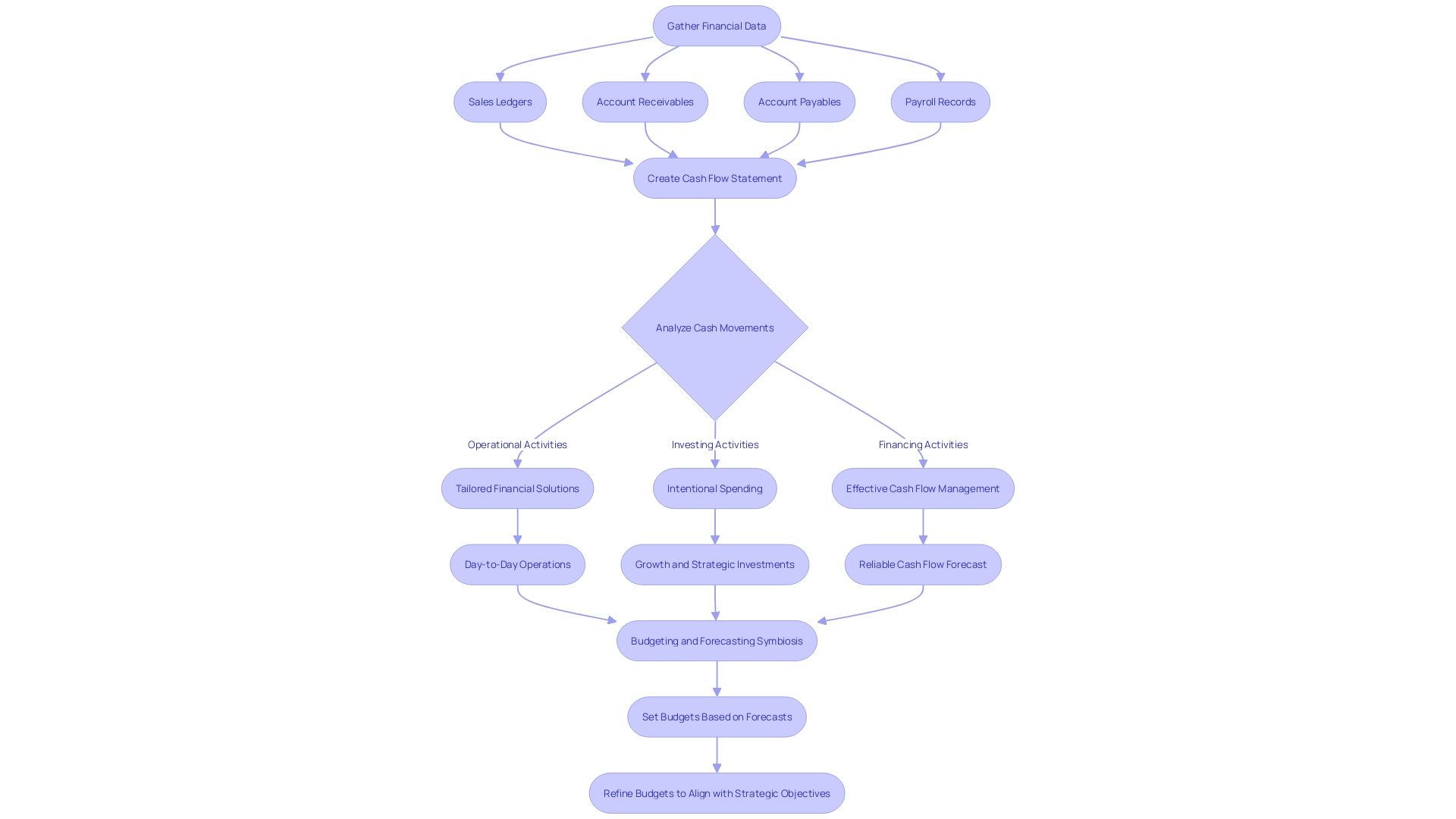
Projecting Income and Expenses
A proficient cash flow forecast hinges on accurately predicting incoming revenues and outgoing expenditures. Delving into the historical financial data, interpreting market trends, and scrutinizing operational forecasts are pivotal to estimating future cash inflows and outflows. A meticulous review of all financial statements, including cash flow statements, income statements, and balance sheets, reveals vital insights into revenue, expenses, profitability, and debt levels. This comprehensive understanding equips CFOs with the ability to pinpoint potential cash flow disparities or excesses, thereby facilitating strategic cash management and resource allocation decisions.
To adeptly navigate cash flow management, CFOs must harness the power of profit and loss statements. These documents demystify the intricate relationship between income and expenses, guiding strategic business maneuvers and investment planning. Employing a well-structured system to track and measure accounts payable and receivable monthly is crucial for assessing monetary movements accurately.
The vitality of cash flow management is underscored by its role as the cornerstone of sustainable, long-term profitability. Cash flow embodies the essence of business vitality—its ebbs and flows dictate an enterprise's ability to cover costs, invest strategically, and ultimately expand. The absence of a robust cash management strategy can precipitate dire consequences, rendering a business incapable of fulfilling its financial obligations.
In light of this, CFOs are encouraged to rigorously evaluate all expenditures, aligning them with the overarching business goals and ensuring every dollar spent contributes to a positive return on investment. This level of prudence is echoed in the real estate sector, where discerning the difference between income and expenses—cash flow—is fundamental to informed investment decisions.
Ultimately, the 13-Week Cash Flow Template serves as an essential tool for CFOs committed to steering their organizations toward financial prosperity. It demands a blend of financial acumen, strategic foresight, and an unwavering commitment to understanding the intricate details of a company's fiscal landscape.

Calculating the Cash Flow
To ensure proactive financial management, the 13-Week Cash Flow Template serves as a vital tool for CFOs to meticulously track and analyze cash movements. The template demands a thorough accounting of all cash inflows, encompassing sales revenue, external funding, and investments, alongside all cash outflows such as operational costs, debt servicing, and capital investments. The precision of these calculations is critical, as it reveals the net cash position for each week, spotlighting imminent cash shortfalls or surpluses.
- Operating Activities: At the heart of the cash flow statement, operating activities encompass the cash inflows from sales and outflows for business operations, adjusting for non-cash items like depreciation, thus reflecting the core business efficacy.
- Investing and Financing Activities: These sections account for the cash transactions related to investments and financing, which can fluctuate significantly and influence liquidity.
- Net Cash Position: The culmination of these calculations manifests as the net cash position, signaling the financial pulse of the organization for the upcoming weeks.
In light of the significance of cash as the lifeblood of business, mastering cash flow management becomes paramount. As illustrated by successful companies like Monday.com, achieving cash flow positivity is a hallmark of efficiency and growth potential. Moreover, the stark reality that even unicorns with billion-dollar valuations can falter without sustainable cash from operations underscores the importance of cash flow management for long-term prosperity.
Furthermore, recent statistics indicate a surge in the number of startups reaching the unicorn status—yet only a select few demonstrate the ability to generate cash from operations at scale, highlighting the rarity and significance of efficient cash flow management.
Enhancing the cash flow analysis, real-world examples like the eCommerce store and consulting services showcase the strategic advantage of low overhead costs and the impact of pricing freedom on cash flow positivity. These case studies exemplify how a robust cash flow enables reinvestment and financial agility.
Ultimately, the 13-Week Cash Flow Template is not just about recording numbers; it's about understanding the financial narrative of a business, enabling CFOs to make informed, strategic decisions that steer their companies towards financial stability and growth.
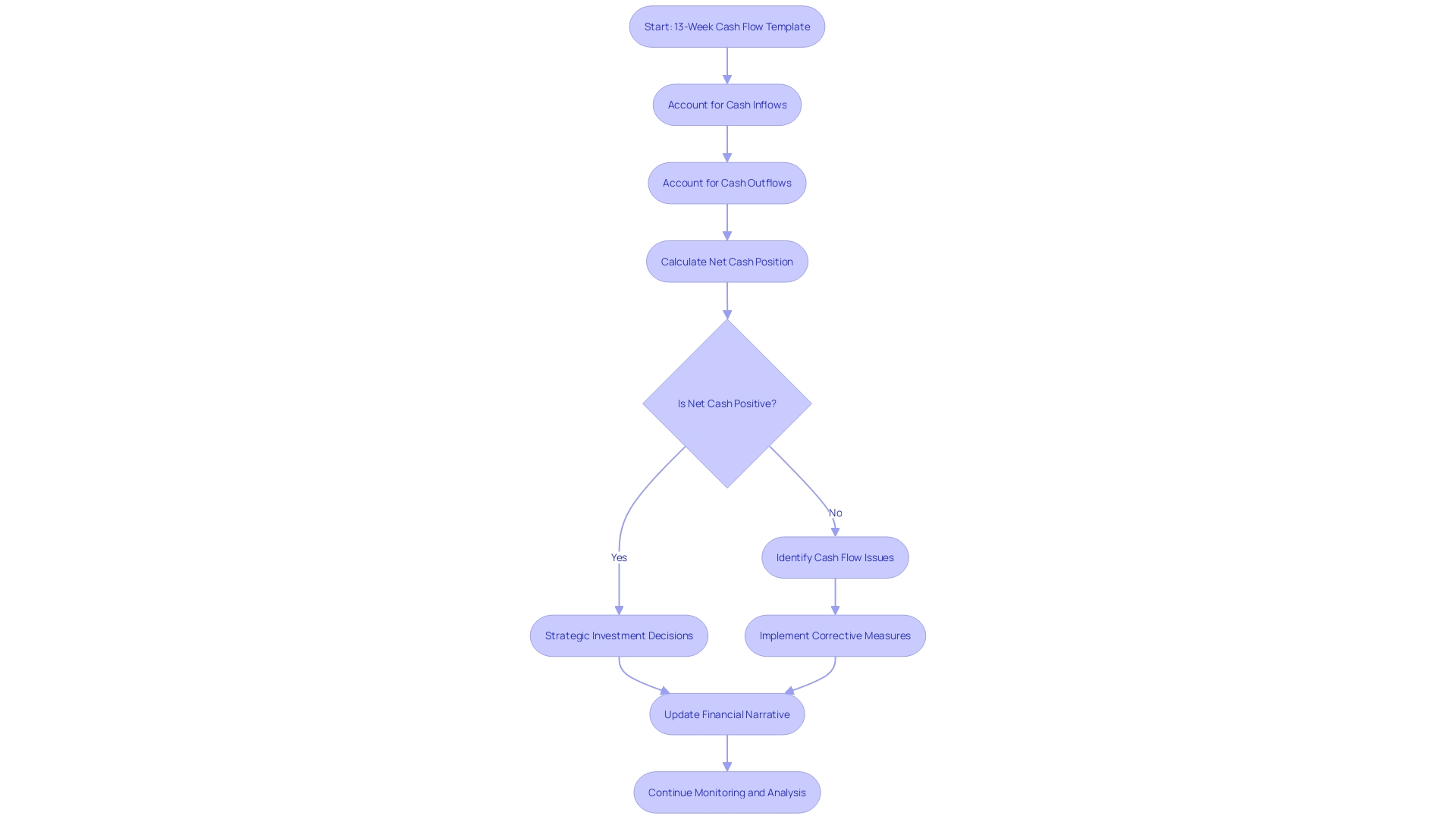
Key Components of a 13-Week Cash Flow Template
A 13-Week Cash Flow Template is a powerful financial tool, enabling precise cash flow analysis and forecasting. Such a template breaks down cash movements into categories of inflows and outflows, bookended by opening and closing cash balances. Weekly cash flow calculations are a pivotal feature, providing a snapshot of financial activity and aiding in liquidity planning. Moreover, incorporating visual aids like charts or graphs translates the financial data into actionable insights, assisting CFOs in grasping the cash flow dynamics within their organization. This proactive approach to cash management is exemplified by companies such as Monday.com, which efficiently grew to become free cash flow positive, thereby maximizing investment capacity, extending their cash runway, and enhancing shareholder value. With the right components, a 13-week cash flow template is not just a report but a strategic roadmap for sustaining and growing a business in an ever-evolving market landscape.
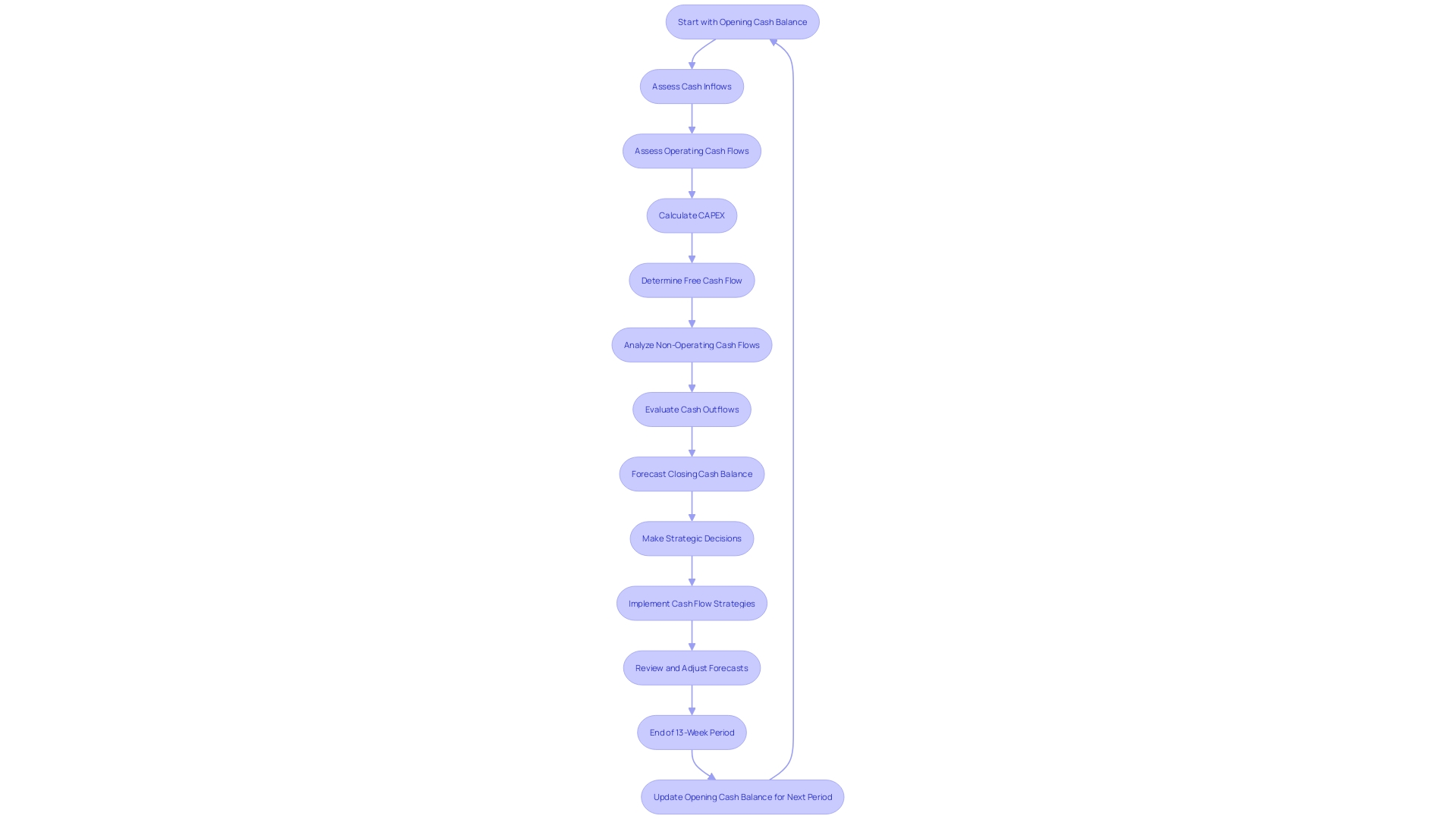
Designing the Basic Structure of the Template
To ensure robust financial health, a 13-Week Cash Flow Template must go beyond a mere accounting tool; it should mirror the unique cash flow rhythm of your business. Incorporate cash inflow and outflow categories that resonate with the nuances of your industry and business model. For eCommerce businesses, this might mean tracking the immediate cash conversion from online sales, while consulting services may require monitoring staggered payments against project milestones. Factor in low overhead costs to highlight the sustainability of cash flow. The template should not only accommodate weekly cash flow figures but also enable annotations for nuanced financial insights. Moreover, staying informed about economic trends, like the current focus on business planning and analysis in response to inflation, can further refine your cash flow forecasting. A well-crafted template is a strategic ally, transforming complex financial data into actionable intelligence, thereby safeguarding your company's liquidity and supporting strategic decision-making.

Implementing Formulas for Automation
Embracing the power of automation within the 13-Week Cash Flow Template can be a game-changer for CFOs looking to refine their financial analysis and forecasting efforts. By integrating functions and formulas that spreadsheet software offers, CFOs are empowered to automate pivotal calculations—including total cash inflows and outflows, alongside the net cash position. The benefits of this approach are twofold: it significantly trims down the time spent on manual calculations and concurrently mitigates the risk of human error, thereby bolstering the precision and dependability of the cash flow forecasts.
Indeed, the efficacy of automation in financial operations is underscored by the experience of Auchan Ukraine. The retailer developed a forecasting model that not only catered to their complex needs but also exhibited the flexibility to be applied with minimal adjustments across different markets, including Romania and France. By harnessing machine learning and AI, the model proficiently forecasted demand for a myriad of food products across 22 hypermarkets, contributing to a substantial reduction in stockouts and overstock by 18% within a year.
Moreover, the finance sector has witnessed a substantial shift with the advent of technologies like AI and machine learning. While still responsible for core finance functions, CFOs are increasingly leveraging these technologies to elevate their roles. For instance, FloQast's CFO Razzak Jallow emphasizes that nearly two decades in the finance and accounting industry have revealed the transformative impact of automation. It's a sentiment echoed by SkyStem's CEO, Shagun, who notes that despite common misconceptions, a significant portion of financial operations—up to 80% as per Accenture—harbor the potential for automation, which can free up valuable time for strategic initiatives.
In light of these developments, it's clear that effectively managing cash flow is not only essential for the survival of a business but also serves as a cornerstone for long-term, sustainable profits. As cash flow reflects the lifeblood of any business, a robust strategy to manage it is indispensable for covering expenses, making strategic investments, and fostering growth. Therefore, the integration of automation within cash flow analysis and forecasting is not merely a luxury—it's an imperative step towards maintaining a competitive edge in the fast-paced realm of finance.
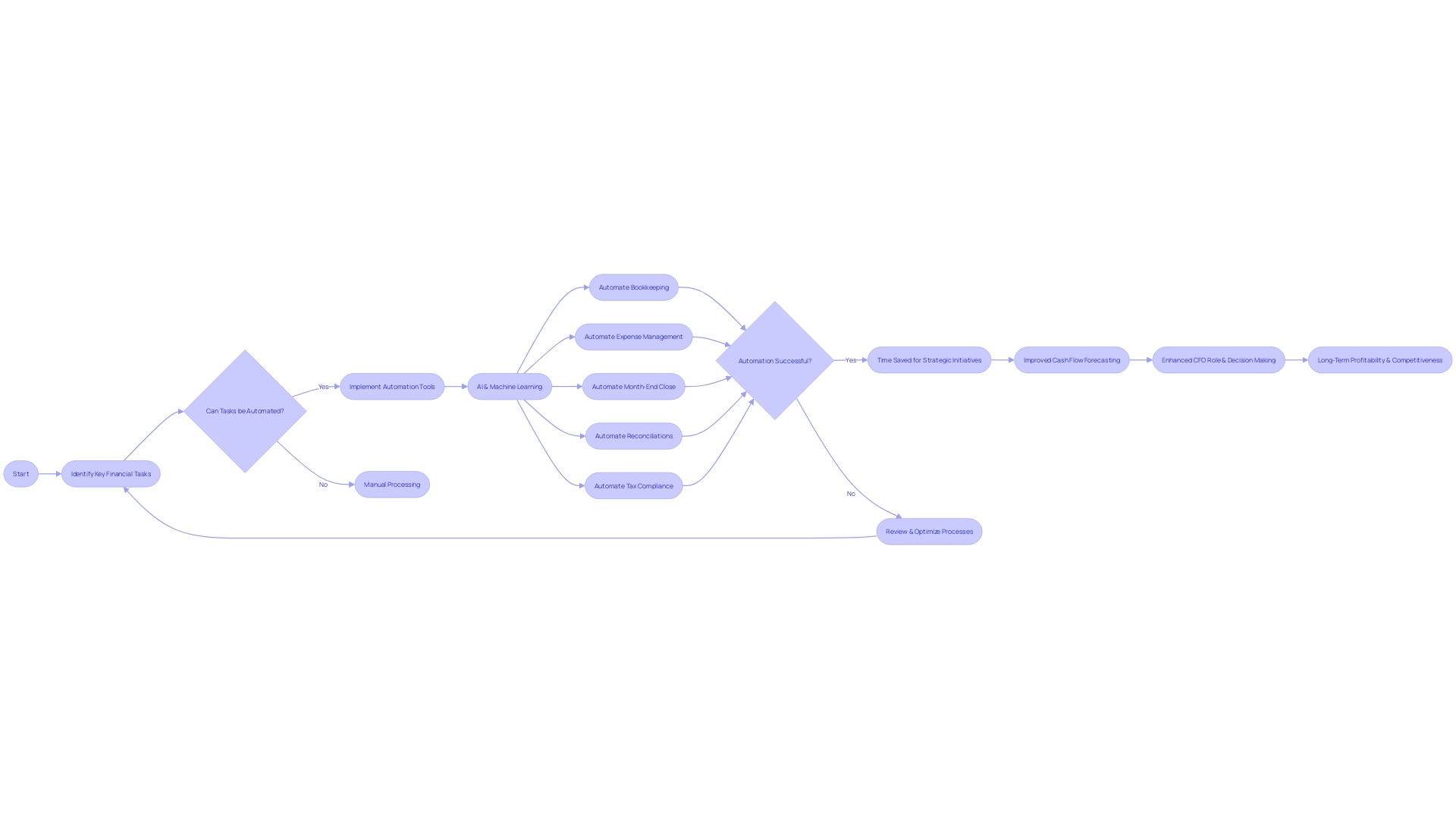
Tips for Accurate and Effective Forecasting
To fortify their cash flow forecasting, CFOs can take a page from the playbook of the few self-sustaining unicorns that have stood the test of time without constant capital injections. This rare breed of company exemplifies financial acumen, particularly in cash flow management. By meticulously analyzing historical data, including revenue, operating costs, and profit margins, CFOs can identify underlying patterns that are critical for accurate forecasting. A comprehensive approach that includes sensitivity analysis to anticipate various market scenarios, integrating seasonality trends, and staying abreast of market dynamics is paramount. Regular updates to forecasts, aligned with real-time financial performance, ensure that predictions remain relevant and actionable. Additionally, incorporating insights from diverse stakeholders within the organization, such as those from Citizens Financial Group's broad suite of services, enriches the forecasting process. This collaborative approach not only leverages internal expertise but also aligns financial strategy with operational activities, ensuring that all parts of the business are moving towards common financial goals.
With 68% of finance leaders willing to consider AI's input in decision-making, as reported by Pigment, CFOs can leverage technology to democratize data access and involve a wider array of team members in the financial planning process. Embracing AI tools can help leaders across departments engage with financial tools without specialized training, thus enhancing the collective financial intelligence of the organization. Ultimately, combining meticulous analysis with technological advancements and cross-departmental collaboration can significantly elevate the precision and utility of cash flow forecasts.

Linking the 13-Week Cash Flow to Strategic Decisions
A 13-Week Cash Flow Forecast is not merely a financial instrument; it's a strategic compass guiding the CFO through the fiscal landscape of the organization. It transcends its role as a predictor of cash ebbs and flows, evolving into a beacon for decision-making on investments, debt management, and financial pathways. This forecasting model aligns the CFO's financial decisions with the organization's overarching goals, mirroring how a city center hotel's location strategy catalyzed an upsurge in its food and beverage sales. Similarly, a cash flow forecast, when managed adeptly, can steer a company towards profitability and growth, as cash flow is the lifeblood of a business, essential for covering expenses and fueling expansion. Just as Toyota learned from their Woven Planet venture, understanding and managing cash flow is paramount, with success hinging on strategic vision and disciplined execution. The forecast serves as the financial narrative of the organization, informed by thorough analysis of financial statements, which according to Dr. Sharon H. Porter, are crucial for grasping the company's monetary dynamics. It's a dynamic plan that, as Theresa Neil suggests, incorporates a safety net of accessible funds and maintains low fixed costs. This 13-week journey through fiscal foresight is a testament to the fundamental principle that knowledge of one’s financial position and the judicious allocation of funds are pillars of business success.
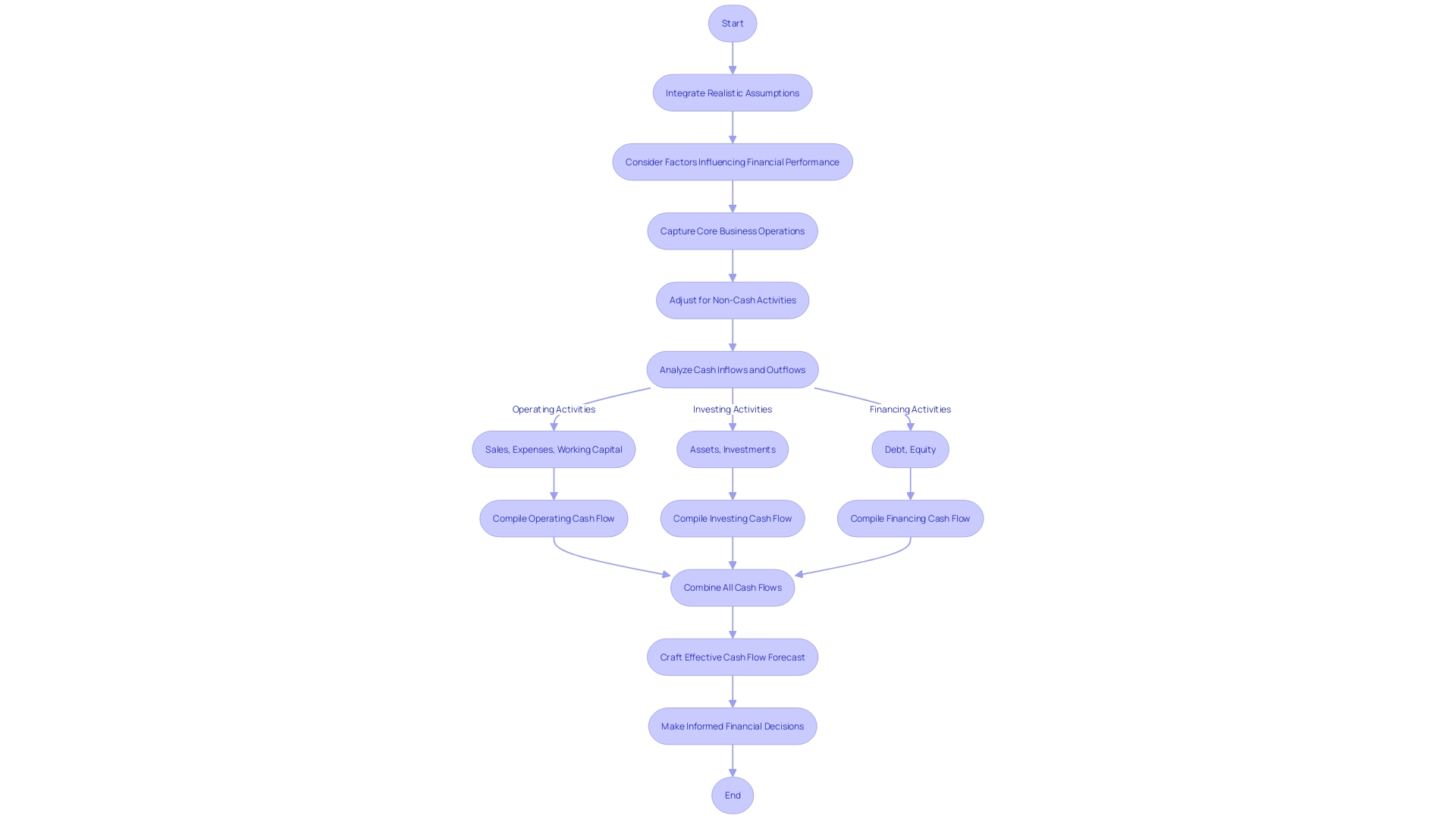
Common Benefits and Applications
Delving into the intricacies of cash flow management with a 13-Week Cash Flow Template provides invaluable foresight for CFOs and financial teams. It serves as a dynamic tool to pinpoint upcoming cash deficits or surpluses, enabling proactive financial governance. With this template, decision-makers can optimize resource distribution, negotiate advantageous terms with vendors and creditors, evaluate organizational performance, and deliver clear financial projections to stakeholders. The mastery of this tool is an edge in steering a business towards fiscal resilience and upward growth trajectories.
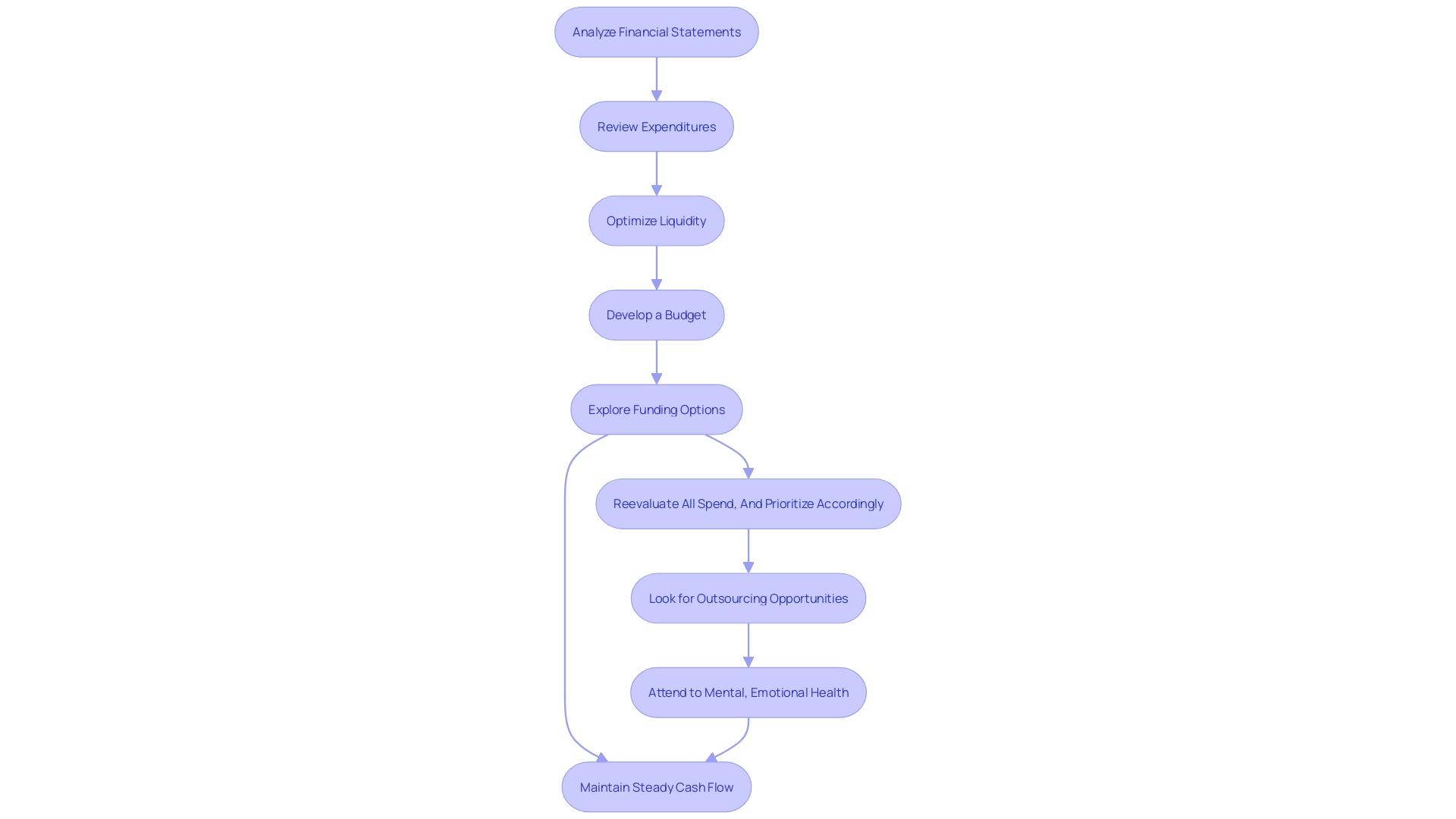
Conclusion
Understanding and managing cash flow is crucial for business success. The 13-Week Cash Flow Template equips CFOs with a detailed view of their company's liquidity, enabling proactive decision-making and meeting financial commitments. A 13-week time frame is optimal for cash flow forecasting, aligning with the natural business cycle and serving as a strategic compass for long-term stability and growth.
Setting up the template involves meticulous data collection and adaptability. Accurate forecasting relies on projecting income and expenses, analyzing historical data, and scrutinizing operational forecasts. Calculating cash flow involves thorough accounting of all inflows and outflows, revealing the financial pulse of the organization.
Automation within the template streamlines financial analysis and forecasting, saving time and reducing errors. To ensure accuracy, CFOs should analyze historical data, conduct sensitivity analysis, and collaborate with stakeholders. The 13-Week Cash Flow Forecast guides financial decisions on investments, debt management, and pathways to profitability and growth.
Utilizing the template offers benefits such as proactive financial governance, resource optimization, and delivering clear projections to stakeholders. It provides invaluable foresight for CFOs, enabling them to steer the organization towards fiscal resilience and growth.
By mastering cash flow management and leveraging the power of the 13-Week Cash Flow Template, CFOs can navigate their organizations towards long-term stability and growth.
Take control of your cash flow and drive business success with our 13-Week Cash Flow Template.




